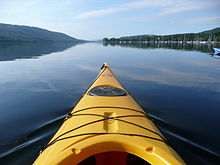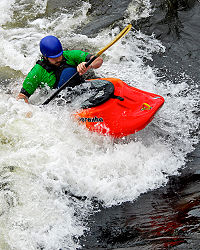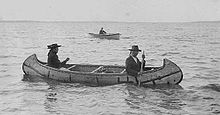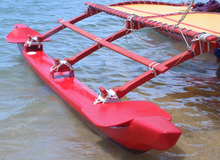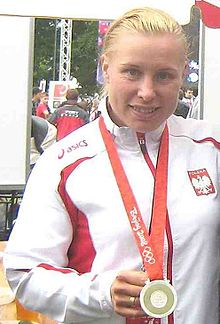- Outline of canoeing and kayaking
-
The following outline is provided as an overview of canoeing and kayaking:
Canoeing is an outdoor activity that involves a special kind of canoe.
Open canoes may be 'poled' (punted), sailed, 'lined and tracked' (using ropes) or even 'gunnel-bobbed'.
Some canoes are called kayaks. When exactly a canoe can be called a kayak is difficult to determine though, and often arbitrary. Internationally, the term canoeing is used as a generic term for both forms though the terms "paddle sports" or "canoe/kayak" are also used. In North America, however, 'canoeing' usually refers only to canoes, as opposed to both canoes and kayaks. Paddling a kayak is also referred to as kayaking. In modern canoe sport, canoes and kayaks are classified together, although these watercraft have different designs, and historical uses. Both canoes and kayaks may be closed-decked. Other than by the minimum competition specifications (typically length and width (beam) and seating arrangement it is difficult to differentiate most competition canoes from the equivalent competition kayaks. The most common difference is that competition kayaks are always seated and paddled with a double-bladed paddle, and competition canoes are generally kneeled and paddled with a single-bladed paddle. Exceptions include Canoe Marathon (in both European and American competitive forms) and sprint (high kneeling position). The most traditional and early canoes did not have seats, the paddlers merely knelt on the bottom of the boat. Recreational canoes and kayaks employ seats and whitewater rodeo and surf variants increasingly employ the use of 'saddles' to give greater boat control under extreme conditions.
Nature of canoeing and kayaking
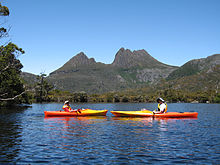 File:Kayaking on Dove Lake, Tasmania
File:Kayaking on Dove Lake, Tasmania
Canoeing and kayaking can each be described as:
- Exercise – any bodily activity that enhances or maintains physical fitness and overall health or wellness.
- Aerobic exercise – physical exercise that intends to improve the oxygen system.[1] Aerobic means "with oxygen", and refers to the use of oxygen in the body's energy-generating process (the citric acid cycle).
- Recreation – an activity of leisure, leisure being discretionary time.[2]
- Sport – an organized, competitive, entertaining, and skillful physical activity requiring commitment, strategy, and fair play, in which a winner can be defined by objective means.
- Transport – the movement of people and goods from one location to another.
- Boating – travel or transport by boat; or the recreational use of a boat (whether powerboats, sailboats, or man-powered vessels such as rowing and paddle boats) focused on the travel itself or on sports activities, such as fishing.
- Watercraft paddling – the act of manually propelling and steering a small boat in the water using a blade that is joined to a shaft, known as a paddle. Not to be confused with watercraft rowing.
- Travel – the movement of people between relatively distant geographical locations for any purpose and any duration, with or without any additional means of transport.
- Tourism – travel for recreational, leisure or business purposes.
- Boating – travel or transport by boat; or the recreational use of a boat (whether powerboats, sailboats, or man-powered vessels such as rowing and paddle boats) focused on the travel itself or on sports activities, such as fishing.
Types of canoeing and kayaking
Canoes and kayaks have been used for transport and fishing for centuries and new uses are continually being developed. Watersports in particular have seen significant growth. Kayaking and canoeing are among the fastest growing outdoor activities in North America. Reports by both the Outdoor Industry Association and the National Sporting Goods Association, with a 15.2 percent increase from 2007 in people in the U.S. choosing kayaking as a leisure time activity.[3] Canoeing has also been claimed as the UK’s biggest participant watersport for five years in succession.[4] Touring and other recreational uses are the most popular type of canoeing and kayaking, as they are suitable for all levels of ability and can be experienced on all types of water from slow flowing rivers, wild 'whitewater' rivers, lakes and estuaries or the seas and oceans.[4] Some of the many popular uses of canoes and kayaks include:
- Canoe camping – is a combination of canoeing and camping, similar to backpacking but canoe campers travel by canoes or kayaks
- Canoe marathon – long distance races on rivers, lakes, estuaries or open sea
- Canoe racing – canoe sprint and canoe marathon are competitive forms of canoeing and kayaking on more or less flat water
- Canoe polo – competitive ball sport played on water in a defined "field" between two teams of 5 players, each in a kayak
- Canoe sailing – invovles fitting a Polynesian outrigger or Western canoe with sails
- Canoe slalom – also called "whitewater slalom", it is a competitive sport where the aim is to navigate a canoe or kayak through a course of hanging gates on rapids in the fastest time
- Extreme racing – paddling a kayak down a section of hard whitewater requiring excellent boat handling skills. The rivers are typically class V and involve waterfalls and dangerous rapids. Races may involve mass-starts or individual timed runs
- Kayak diving – a type of recreational diving where the divers paddle to a diving site in a kayak carrying all their gear to the place they want to dive
- Kayak fishing – fishing from a kayak
- Outrigger canoeing – sport in which an outrigger canoe (vaʻa, waʻa, and waka ama in Tahitian, Hawaiian, and Māori languages, respectively; is propelled by paddles
- Playboating – discipline of whitewater kayaking or canoeing where the paddler performs various technical moves in one place (a playspot)
- Snowkayaking – a winter sport practised by canoeists where the track for the athletes consists of ski tracks in the mountains
- Surf kayaking – the sport of surfing ocean waves with kayaks
- Squirt boating – a form of whitewater kayaking or canoeing where the boat is designed to be as low in volume as possible
- Wildwater canoeing – a competitive discipline of canoeing in which kayaks or Canadian canoes are used to negotiate a stretch of river speedily
- Whitewater kayaking – sport of paddling a kayak on a moving body of water, typically river rapids. The term usually applies to a whole trip or run, which has at least some stretches of whitewater included.
Equipment used for canoeing and kayaking
Canoes and kayaks
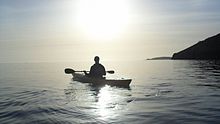 Kayaking on the Helford River
Kayaking on the Helford River
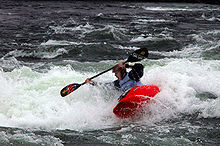 Whitewater rapids of Pite river, Lappland
Whitewater rapids of Pite river, Lappland
- Canoe (North American English) or "Canadian canoe" (British English) – small boat, pointed at both ends, propelled by paddlers who kneel or sit on a raised seat and use paddles which usually have a blade at one end only. A canoe is normally used by two people.[5] A canoe is usually open on top, but can be decked over (i.e. covered, similar to a kayak). A canoe is typically human-powered, though it may also be powered by sails or a small electric or gas motor. Paddles may be single-bladed or double-bladed.
- Kayak – slim boat, normally pointed at both ends and usually propelled by one kayaker who sits in a low seat and uses paddles with a blade at each end. Kayaks usually have a covered deck, with a cockpit covered by a spraydeck to keep the inside of the boat (and the paddler's lower body) dry.
- Differences between a canoe and a kayak:
- Sitting position: In a canoe the paddler either kneels on the bottom of the boat or sits on a raised seat. In a kayak the paddler sits on a low seat with their legs extended in front.
- Number of blades on the paddle: A canoe paddle usually has a blade on one end, while a kayak paddle is bladed at both ends.
- Scope of the name: In some parts of the world, such as the United Kingdom, kayaks are considered a subtype of canoes. Continental European and British canoeing clubs and associations of the 19th Century used craft similar to kayaks, but referred to them as canoes. This explains the naming of the International and National Governing bodies of the sport of Canoeing.
Modern designs
- Modern design features
- Materials used in modern designs – modern kayaks are usually made from Rotationally Molded Plastic (Rotomold), Fiberglass or Kevlar, each of which has advantages and disadvantages.
- Rotomold – very durable and ideal for kayaking over rocks; it is the most widely used material and the cheapest.
- Fiberglass – lighter, but requires much more careful handling and is more costly to produce.
- Kevlar – lighter than fiberglass and stronger than Rotomolded plastic (it is the same material used in bulletproof vests) but is the most expensive.[6]
- Royalex – some whitewater canoes are now made using this composite material which has an outer layer of vinyl and ABS with an inner layer of foam, bonded by heat treatment.[7]
- Materials used in modern designs – modern kayaks are usually made from Rotationally Molded Plastic (Rotomold), Fiberglass or Kevlar, each of which has advantages and disadvantages.
- Modern canoe/kayak designs – in general, each of the activities mentioned above requires a type of boat specifically designed for that activity.
- Concrete canoe – canoe made of concrete, typically created for an engineering competition similar in spirit to that of a cardboard boat race–make the seemingly unfloatable float.
- Fishing kayak – kayak equipped with after-market accessories such as anchor trolleys, rod holders, electronic fish-finders and live-bait containers for fishing
- Flyak – hydrofoil adaptation to the conventional kayak. It uses twin hydrofoils designed to raise the hull out of the water to increase the speed. Speeds of up to 27.2 km/h (7.6 m·s−1, 16.9 mph) can be achieved on calm water.[8]
- Folding kayak – kayak with collapsible frame made of some combination of wood, aluminium and plastic, and a skin made of a tough fabric with a waterproof coating
- Inflatable kayak – portable low cost kayak of inflatable polythene
- International Canoe – a high performance sailing canoe with a planing hull, mainsail and a jib
- Malia (Hawaiian canoe) – a Hawaiian-style wooden racing canoe
- Recreational kayak – kayak designed for the casual paddler interested in recreational activities on lakes or flatwater
- Sea kayak – a kayak developed for the sport of paddling on open waters of lakes, bays and the ocean
- Surf kayak - a boat with a surfboard-shaped hull and tail fins, for riding ocean waves and green, non-breaking river waves.
- Sit-on-top kayak – enclosed kayak which is virtually unsinkable, designed for the paddler to sit on top, but which does not keep the paddler warm and dry.[5]
- Sprint canoe – special type of canoe designed for the sport of flatwater canoe racing; it is slim, is paddled while kneeling on one knee, and the paddler never switches sides.
- Whitewater kayak/canoe - most designs are easily converted from kayak (K-1) to canoe (C-1) by changing the seat. The kayak outfitting is the most common.
- Creek Boat - a medium-length, high-volume boat with blunt ends, specialized for steep creeks and waterfalls, for whitewater up to class 6.
- River Runner - a longer, faster, high-volume boat, specialized for class 3 rapids and flatwater sections between rapids.
- Slalom - the fastest possible low-volume design in a 3.5-meter-length maneuvering race boat.
- Freestyle Playboat - the shortest possible, wide, planing-hull (flat-bottomed) boat for surfing and aerial tricks on standing waves and in hydraulic holes. Competitions are scored for difficulty of maneuver.
- Squirt boat - a long, extremely low-volume boat designed to sink below the surface in eddy lines.
- Wildwater race boat - the longest, fastest boat for downriver whitewater racing, very difficult to maneuver.
Traditional designs
- Traditional design features
- Materials used in traditional designs
- Wooden frame – traditional kayaks and canoes are usually built from a wooden frame, usually western red cedar.
- Cover – the frames of traditional kayaks and canoes are usually covered with specially treated hide or waterproof material.
- Materials used in traditional designs
- Traditional canoe/kayak designs – most traditional designs are based on centuries of experience of fishing and seal hunting but can be expensive, as they are they are often hand built to specific requirements.[9]
- Aleutian kayak – made by the people of the Aleutian Islands primarily from driftwood covered with the seal skins
- Baidarka – name sometimes used for Aleutian style sea kayak originating from early Russian settlers in Alaska
- Cayuco – a wooden canoe carved made from the hollowed out trunk of a tree used mainly in South America
- Chundan Vallam – (Beaked Boat) also known as Kerala snake boats used in boat races
- Outrigger canoe – canoe with one or more lateral support floats known as outriggers fastened to one or both sides of the main hull
- Sturgeon-nosed canoe – designed with a reversed prow for use through bulrushes and maneuverability in turbulent waters
- Taimen – type of folding kayak popular in Russia
- Umiak – Eskimo canoe made from driftwood frames pegged and lashed together with covering of walrus or seal skin
- Waka – Māori canoes ranging from small (waka tīwai) used for fishing and river travel to large decorated war canoes (waka taua) up to 40 metres (130 ft) long
- War canoe – originally derived from large canoes intended for war, 'war canoes' are now used for racing in Canada
Other canoeing and kayaking equipment
- Buoyancy aid – a specialist form of personal flotation device (PFD) used most commonly by kayakers and canoeists
- Albano buoy system – a way of marking out kayak, canoe and rowing race courses using lines of buoys
- Paddle float – buoyance aid fitted to paddle used for re-entry into a kayak after a capsize in open water. It may also be used for practice kayak rolling
- Outrigger – a solid hull used to stabilise a canoe and positioned rigidly and parallel to the main hull so that it is less likely to capsize
- Paddle – used in kayaks and canoes for propulsion and made of plastic, wood, fiberglass, carbon fiber or metal. Paddles for use in kayaks are longer, with a blade on each end and are handled from the middle of the shaft
- Paddle leash – used for securing a paddle in open water especially on solo tours where a paddle may drift away through wind or waves and be lost
- Sea sock – a large waterproof bag placed inside the kayak and attached tightly all around the rim of the cockpit so that the paddler can sit inside and prevent the kayak filling with water in a capsize
- Spraydeck – flexible cover for a kayak or a canoe used in whitewater or inclement weather to prevent water from entering the boat while paddling
- Tuilik – a traditional Greenland paddling jacket and spray shirt integrated into one piece of clothing, sealed at the face, wrists and around the cockpit coaming enabling the paddler to do an eskimo roll without getting wet
Canoeing and kayaking techniques
 An intentionally initiated Kayak Roll
An intentionally initiated Kayak Roll
- Capsize recovery
- Eskimo Rescue – manoeuvre performed to recover from a capsize, while grasping another kayak.
- Kayak roll – act of righting a capsized kayak by use of body motion and/or a paddle.
- C-to-C Roll – a type of kayak roll.
- Kluning – a term for when an obstacle is blocking the way and the canoe or kayak has to be taken out of the water
- Portage – carrying watercraft or cargo over land to avoid river obstacles, or to get to another body of water.
Canoeing and kayaking locations
- Playspot –
- Rapids – fast flowing section of a river.
- Whitewater – water thrashed around and aerated by the turbulence of a fast enough rapid that some of it turns frothy white.
- Artificial whitewater courses – special sites usually for competition or commercial use where water is diverted or pumped over a concrete watercourse to simulate a range of different water situations that can be controlled consistently
- Whitewater rivers – rivers with one or more stretches of whitewater rapids.
- Whitewater – water thrashed around and aerated by the turbulence of a fast enough rapid that some of it turns frothy white.
Specific venues
- Boulter's Lock –
- Boundary Waters Canoe Area Wilderness –
- Cardiff International White Water –
- Canolfan Tryweryn –
- Cardington Artificial Slalom Course –
- Dickerson Whitewater Course –
- Dorney Lake –
- Dutch Water Dreams –
- Eiskanal –
- Hawaii-sur-Rhone –
- Helliniko Olympic Canoe/Kayak Slalom Centre –
- Holme Pierrepont National Watersports Centre –
- Hurley Lock – lock and weir on the River Thames in England, situated in a clump of wooded islands close to the village of Hurley, Berkshire.
- Idroscalo –
- Kanupark Markkleeberg –
- Lee Valley White Water Centre –
- River Thames –
- Millrace Rapids –
- Nene Whitewater Centre –
- Northern Forest Canoe Trail –
- Ocoee Whitewater Center –
- Ohio River Trail –
- Parc Olímpic del Segre –
- Penrith Whitewater Stadium –
- Račice, Czech Republic –
- River Dart –
- Rutherford Creek –
- Saint Regis Canoe Area –
- Shunyi Olympic Rowing-Canoeing Park –
- South Bend –, Indiana
- Stanley whitewater canoeing course –
- Symonds Yat Rapids –
- Tacen Whitewater Course –
- Teesside White Water Course –
- Texas Water Safari –
- The Loop, River Dart –
- Tour de Gudenå –
- U.S. National Whitewater Center –
- Upper Dart –
- Water Sports Centre Čunovo –
- Wolf River (Tennessee) –
Canoeing and kayaking competitions
- Canoeing and kayaking at the Summer Olympics
- Canoeing at the Asian Games – events contested at every Asian Games since 1990 Asian Games in Beijing
- Adirondack Canoe Classic – also known as the 90-miler, is a three-day, 90-mile (140 km) canoe race from Old Forge to Saranac Lake in the Adirondacks of New York, USA
- Backwaters Paddle Quest – a canoe-based sprint held annually in Stevens Point, WI on the Wisconsin River[10]
- Breede River Canoe Marathon – an annual South African K2 (doubles) race down the Breede River from Robertson to Swellendam in the Western Cape over a distance of 75 km
- Berg River Canoe Marathon – takes place annually in South Africa's Western Cape Province over a distance of some 240 km from Paarl to the small harbour of Velddrif on the West Coast
- Devizes to Westminster International Canoe Marathon – a marathon canoe race in England held every Easter over a course of 125 miles (201 kilometres) from Devizes in Wiltshire to Westminster in central London.
- Dusi Canoe Marathon – a canoe (or rather, kayak) race between Pietermaritzburg and Durban, South Africa, run along the Msunduzi River (commonly referred to as the Dusi or Duzi)
- Fish River Canoe Marathon – a two-day event taking place every October on South Africa's Fish River in the Eastern Cape Province over a distance of some 81 km
- ICF Canoe Sprint World Championships & ICF Canoe Slalom World Championships – two international events in canoeing organised by the International Canoe Federation
- Texas Water Safari – a trek down waterways from San Marcos, Texas, to Seadrift, Texas
Canoeing and kayaking organisations
- American Canoe Association – (ACA) is the largest paddle sports organization in the US
- American Whitewater - (AWA) the primary advocate for the preservation and protection of whitewater resources throughout the United States
- British Canoe Union – (BCU) the National Governing Body for the sport of canoeing and kayaking in the UK
- Canadian Canoe Association – governing body of competitive canoeing and kayaking disciplines in Canada.
- Canoe Wales – the governing body for canoeing and kayaking in Wales
- International Canoe Federation – (ICF) the umbrella organization of all national canoe organizations worldwide and administers all aspects of canoe sport
- USACK – the USA Canoe and Kayak National Governing Body for the Olympic sports of Flatwater Sprint and Whitewater Slalom.[11]
Notable canoeists and kayakers
 Birgit Fischer (left) with Freya Hoffmeister
Birgit Fischer (left) with Freya Hoffmeister
Voyagers and adventurers
- Paul Caffyn – New Zealand sea kayaker has completed a number of supported, unsupported, solo and group expeditions by sea kayak in various locations around the world
- Chris Duff – American expedition sea kayaker notable for his large scale projects and world-record breaking attempts. Since 1983, he has kayaked over 14,000 miles.[12]
- Nigel Foster – first and youngest paddler to circumnavigate Iceland 1977, first solo crossing of Hudson Strait from Baffin Island to Northern Labrador 1981
- Freya Hoffmeister – German woman who holds several sea kayaking endurance records and in 2009 was the first woman to complete a circumnavigation of Australia solo and unassisted,[13][14]
- Andrew McAuley – was an Australian adventurer best known for sea kayaking in remote parts of the world who is presumed to have died following his disappearance at sea while attempting to kayak 1600 km across the Tasman Sea in February 2007
- Alex Prostko – American whitewater kayaker who made the first legal descent of Section I of the Chattooga River in over 30 years.[15]
- Helen Skelton – kayaked the entire length of the River Amazon for Sport Relief in 2010
- Oskar Speck – was a German canoeist who paddled by folding kayak from Germany to Australia over the period 1932–1939
Olympic medalists
Canadian
- Frank Amyot – Canadian Olympic gold medalist
- Caroline Brunet – Canadian Olympic silver medalist
- Larry Cain – Canadian Olympic gold and silver medalist
- David Ford – Canadian Olympic slalom canoeist who has competed since the early 1990s
- Hugh Fisher – Canadian Olympic gold and bronze medalist
- Steve Giles – Canadian Olympic bronze medalist
- Thomas Hall – Canadian Olympic bronze medalist
- Sue Holloway – Canadian Olympic silver and bronze medalist
- Adam van Koeverden – Canadian Olympic gold, silver and bronze medalist
- Alwyn Morris – Canadian Olympic gold and bronze medalist
German
- Birgit Fischer – German kayaker who has won eight gold medals over six different Olympic Games
Other
- Gábor Horváth – Hungarian sprint canoer who competed in three Summer Olympics
- Eric Jackson – world-champion freestyle kayaker and kayak designer
- Jan Johansen – Norwegian sprint canoer who won a gold medal at the 1968 Summer Olympics in Mexico
- György Kolonics – Hungarian sprint canoer who won four Olympic medal in Canadian and record 29 ICF Canoe Sprint World Championships in Canadian discipline.
- Aneta Konieczna – Polish sprint canoer who won three Olympic medals in the K-2 500 m event with one silver (2008 and two bronzes (2000, 2004)
- Katalin Kovács – Hungarian sprint canoer. Winner of six Olympic medals and a record-tying (with Birgit Fischer) 38 ICF Canoe Sprint World Championships medals.
- Carlos Pérez – Galician sprint canoer who a gold medal in the Beijing Olympics in 2008
- Anna Wood – Dutch-born Australian sprint canoer who competed from the early 1980s to the early 2000s in four Summer Olympics and won two bronze medals
- Clay Wright – professional whitewater kayaker and kayak designer
ICF Canoe Sprint World Championships medalists
- List of ICF Canoe Sprint World Championships medalists in men's Canadian
- List of ICF Canoe Sprint World Championships medalists in men's kayak
- List of ICF Canoe Sprint World Championships medalists in women's kayak
- List of ICF Canoe Sprint World Championships medalists in paracanoe
References
- ^ Concise Oxford English Dictionary (Eleventh Edition)
- ^ Thomas S. Yukic. Fundamentals of Recreation, 2nd edition. Harpers & Row, 1970,. p. 1f.
- ^ "Kayaking/Canoeing: Travel Sport Exploding In Popularity". http://www.travelersanonymous.com/component/content/article/26-architectural-perspective/234-kayakingcanoeing-travel-sport-exploding-in-popularity. Retrieved 16 November 2010.
- ^ a b "Canoeing and Kayaking". http://www.sailingandboating.co.uk/CanoeingKayaking.html. Retrieved 16 November 2010.
- ^ a b "Sea kayaks vs. other kayaks and canoes". Kayarchy – the sea kayaker's online handbook and reference. http://www.kayarchy.co.uk/html/01equipment/010otherkayaks.htm. Retrieved 13 November 2010.
- ^ "Kayak Materials". http://www.kayakforlife.com/kayak-materials.htm. Retrieved 20 November 2010.
- ^ "Royalex (RX)". http://www.roscocanoes.com.au/FAQ%60s/Materials%20%20Manufactoring/Royalex%20(RX)-253.aspx. Retrieved 20 November 2010.
- ^ How the Foilkayak works page detailing speed statistics
- ^ "The modern skin on frame kayak". http://www.capefalconkayak.com/The%20modern%20skin%20on%20frame%20kayak.html. Retrieved 20 November 2010.
- ^ "Paddle Quest Challenges Nationwide Canoeists". Wsaw.com. 2009-08-08. http://www.wsaw.com/home/headlines/52797462.html?FORM=ZZNR7. Retrieved 2010-12-27.
- ^ "About USA Canoe/Kayak | USA Canoe/Kayak". Usack.org. http://www.usack.org/content/index/1. Retrieved 2010-12-27.
- ^ Sea Kayaking UK
- ^ "German Freya Hoffmeister today became the first woman to circumnavigate Australia in a sea kayak". Herald Sun (Australia). Herald Sun (Australia). 2009-12-15. http://www.heraldsun.com.au/news/german-freya-hoffmeister-today-became-the-first-woman-to-circumnavigate-australia-in-a-sea-kayak/story-e6frf7jo-1225810656268. Retrieved 13 November 2010.
- ^ "Finish at Queenscliff". qajakunderground.com 15 December 2009. http://qajaqunderground.com/2009/12/14/circumnavigation-finish-at-queenscliff. Retrieved 2009-12-15.
- ^ American Whitewater – Team completes First legal upper Chattooga descent in 30 years
External links
- Canoekayak magazine
- International Canoe Federation The International federation of kayak and canoe bodies
- About.com Paddling -Technique, Safety, Photos, and Gear Reviews
- KayakPaddling.net Animated kayak paddling tutorials – multilingual
- The Canadian Museum of Civilization – Native Watercraft in Canada
- Kayak for Life – information about all aspects of kayaking and kayak safety equipment
- British Canoe Union The National Governing Body of Kayaking in the UK
- USA Canoe and Kayak The National Governing Body of Kayaking in the US
- Wikipaddle – Online canoe and kayak wiki guide.
Outlines - General reference
- Culture and the arts
- Geography and places
- Health and fitness
- History and events
- Mathematics and logic
- Natural and physical sciences
- People and self
- Philosophy and thinking
- Religion and belief systems
- Society and social sciences
- Technology and applied sciences
- Exercise – any bodily activity that enhances or maintains physical fitness and overall health or wellness.
Wikimedia Foundation. 2010.

